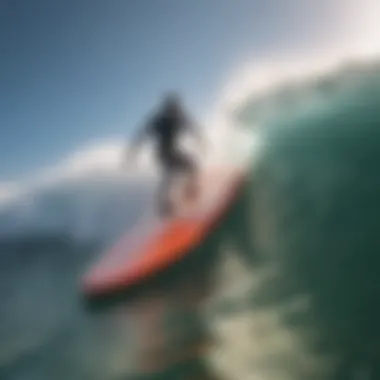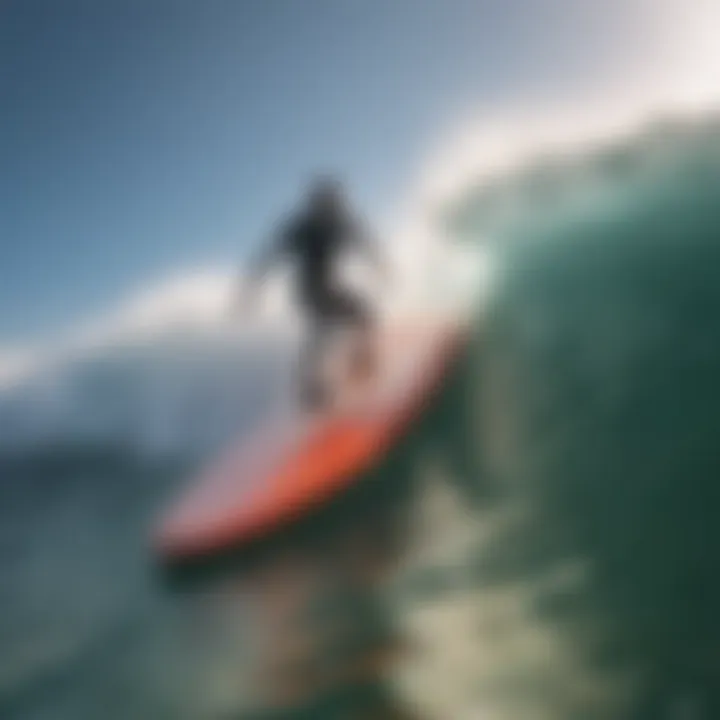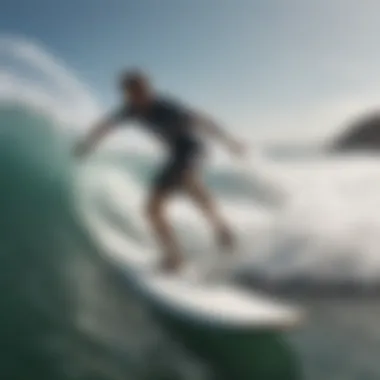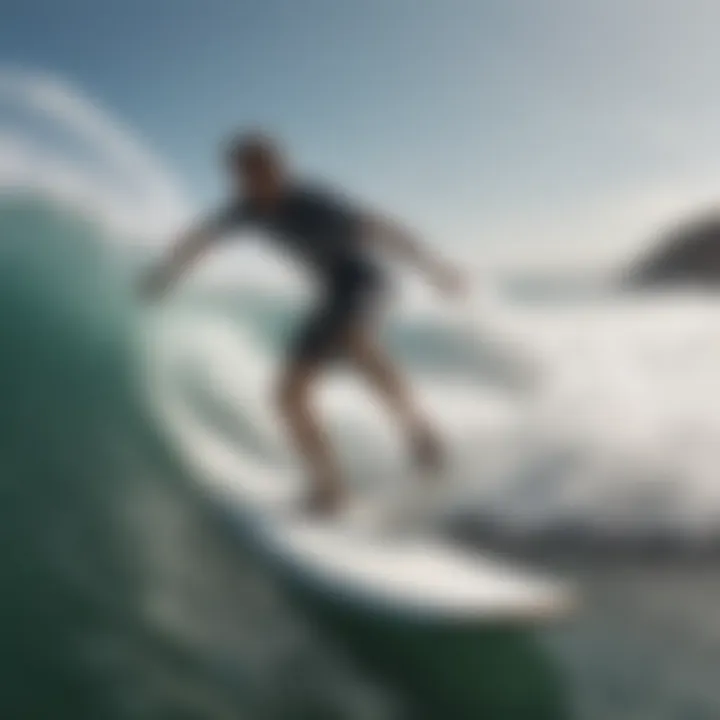Exploring Big Wakesurf Boards: Design and Impact


Intro
Wakesurfing has come a long way, becoming more than just a niche water sport. It's a culture, a lifestyle, and for many, a pathway to connect with nature and others. Big wakesurf boards, specifically, have carved out their own unique space in this vibrant community. They offer not only ample stability and buoyancy but also invite surfers to experience the waves in a way that’s both thrilling and accessible. Navigating the details about these boards can help enhance one’s performance, ensure sustainable practices, and draw from the latest technological advancements on the market.
This article will delve into the vast landscape of big wakesurf boards, covering everything from design and functionality to their impact on user performance. We will dissect the materials used in manufacturing these boards and explore their various shapes and styles. Moreover, we aim to shed light on eco-friendly practices that are gaining traction within the wakesurfing community, further enhancing the overall experience of surfers around the globe.
Understanding how to select the right board and gear can significantly elevate the wakesurfing experience. We'll discuss techniques for both beginners finding their feet and seasoned surfers looking to push the envelope.
Surfboarding Techniques
Beginner Tips for Mastering the Basics
Starting out in wakesurfing can feel daunting, but there are essential strategies that can help simplify the learning curve. First and foremost, it’s all about balance. Here are a few tips:
- Foot Placement: Position your feet shoulder-width apart and center your weight evenly. Too much weight on the back can cause the board to nosedive.
- Grip the Handle: Keep a relaxed grip on the handle. It should feel like an extension of your body, not a lifeline.
- Stay Low: Bending your knees and lowering your center of gravity can help maintain stability and control.
- Look Ahead: Focusing on where you want to go rather than what’s right in front of you can aid in smoother turns and maneuvers.
Advanced Techniques for Seasoned Surfers
Once you’ve got the basics down, you might want to tackle more advanced maneuvers. Consider the following:
- Carves and Turns: Lean into your turns while maintaining pressure on the rail. This helps carve out cleaner lines on the wave.
- Tricks and Spins: Start with simpler tricks like 180-degree spins, gradually moving to complex moves like aerials as your confidence grows.
- Wave Riding: Learn to read the wave; understanding its shape can maximize your ride and keep you in the sweet spot, allowing for longer runs.
"The beauty of wakesurfing lies not only in the waves but also in the community and sustainability of the sport."
Surfboard Equipment
Reviews of the Latest Surfboards on the Market
When it comes to selecting the right wakesurf board, the options available can be overwhelming. Boards vary greatly depending on design and intended use. Some trending boards to note include:
- Hyperlite Landlock: Known for its stability and glide, making it perfect for beginners.
- Ronix Koal Classic: Offers great versatility with its lightweight design, suitable for pros and casual surfers alike.
- Liquid Force Swami: Its enhanced maneuverability and surfy feel provide an effortless ride, particularly great for those working on tricks.
Essential Gear for Every Surfboarder
Aside from the board itself, having the right gear can significantly improve your experience. Here are some essentials:
- Wakesurf Vest: A properly fitting vest enhances buoyancy and safety without restricting movement.
- Leash: A quality surf leash keeps your board close when you wipe out, helping prevent loss or injury.
- Sunscreen: Protecting your skin is crucial, especially during long days on the water; choose a reef-safe option to respect the environment.
The world of wakesurfing is complex yet rewarding, and understanding the right techniques and equipment can enrich your adventure on the water. By embracing the blend of performance and sustainability, surfers can ensure that their passion for wakesurfing contributes positively to both personal enjoyment and the larger community.
Prologue to Wakesurfing
Wakesurfing is not just a sport; it's a lifestyle that melds the thrill of surfing with the serene atmosphere of water. In recent years, it has gained momentum, drawing enthusiasts from various backgrounds who seek the unique experience that only wakesurfing offers. This section delves into the core elements of wakesurfing, substantiating its significance as a precursor to understanding big wakesurf boards, particularly for surfers, instructors, adventurers, and eco-enthusiasts.
The Definition of Wakesurfing
So, what exactly is wakesurfing? At its essence, wakesurfing involves riding a surfboard atop the wake generated by a specially designed boat while maintaining a distance, typically between 5 and 15 feet, from the vessel itself. This distance is paramount, as it allows surfers to glide on the water’s surface without being pulled by a rope. To many, it’s the sensation of freedom akin to surfing on ocean waves, but it often takes place on lakes or rivers, blessed with a smoother ride.
Here are some of the defining characteristics of wakesurfing:
- No tow rope: Instead of getting towed, surfers balance themselves on the wake, gaining freedom of movement.
- Local lakes and rivers: Wakesurfing is commonly enjoyed in tranquil waters, making it accessible to many enthusiasts.
- Variety of boards: Different styles of wakesurf boards cater to a range of skill levels and riding preferences, particularly emphasizing the importance of big wakesurf boards.
As you can see, wakesurfing is not simply about being on the water; it embodies a unique blend of skill, balance, and connection to nature that pulls many into its sway.
Evolution of Wakesurfing
Tracing the evolution of wakesurfing takes us back to its humble beginnings in the late 20th century. Originally, surfers would cling to a rope dragged by a boat, gradually letting go as they found their balance. It was a harder approach and required considerable skill to master. However, the game changed markedly with advancements in boat design and technology, leading to the development of dedicated wakesurf boats that could create larger and cleaner wakes.
Over the past two decades, wakesurfing has morphed from a niche sport to a mainstream activity. Here are some pivotal moments:
- Enhanced boat designs: Modern boats are engineered with specialized hull shapes for optimal wakes, transforming the sport.
- Emergence of wakesurf brands: Companies began producing gear specifically tailored for wakesurfing, including big wakesurf boards.
- Community growth: Wakesurfing clubs and events emerged, fostering a tight-knit community passionate about sharing the sport.
This transition paved the way for innovations in board designs, particularly the larger boards, which now dominate the marketplace. Today’s wakesurfers enjoy an unprecedented variety of options tailored to their skills and preferences, marking a significant shift in the landscape of the sport.


Understanding Big Wakesurf Boards
In the realm of wakesurfing, big boards stand as a unique class, crafted meticulously to cater to various riders. Understanding big wakesurf boards is not merely about their size; it extends into the intricate details that define their performance and usability. These boards cater to diverse rider preferences, skill levels, and conditions. They offer a smoother ride and are especially beneficial for those starting their journey in the sport or those who desire stability.
Characteristics of Big Wakesurf Boards
Big wakesurf boards distinguish themselves through several key characteristics:
- Length: Typically exceeding 5’6”, these boards provide the buoyancy necessary for a more stable ride.
- Width: Wider-than-average boards result in increased surface area, which contributes to greater stability and ease during rides.
- Thickness: Generally thicker than regular boards, offering enhanced floatation, which is especially advantageous for beginners.
- Tail Shape: Various tail shapes affect performance; for instance, a square tail offers more stability, while a rounded tail might allow for sharper turns.
All these characteristics come together to enhance the riding experience, producing a board that is forgiving and comfortable for less experienced riders while still offering advanced techniques for those who seek them.
Benefits of Larger Board Sizes
Choosing larger boards carries numerous benefits:
- Stability: Larger boards provide better balance, making it easier for beginners to find their footing on the water.
- Increased Floatation: The extra buoyancy keeps the rider afloat, reducing fatigue and allowing longer sessions.
- Smooth Ride: An expansive surface area glides effortlessly over wakes, absorbing shock more efficiently than smaller boards which can translate to less strain on the body.
- Versatility: The design of these boards makes them suitable for various conditions, allowing riders to adapt to different waves and wakes with ease.
"The right board can transform the learning curve into a smooth glide, fostering confidence in even the most timid of riders."
Whether a novice or an experienced surfer looking for a more relaxed ride, understanding the intricacies and advantages of bigger wakesurf boards paves the way for a more enjoyable time on the water. The characteristics and benefits emphasized are crucial in making the right choices, ensuring each session is a step towards mastery in wakesurfing.
Design Aspects of Big Wakesurf Boards
The design of big wakesurf boards stands at the crossroads of innovation and performance. Each element contributes time and again to the overall surfing experience. The choice of materials, board shape, and fin configuration aren't just specifications; they're the backbone of a rider’s performance. With these design aspects intricately connected, understanding them can make a world of difference to surfers, from casual riders to seasoned pros.
Materials Used in Construction
When it comes to big wakesurf boards, the materials used in their construction heavily influence durability and performance. Different materials deliver various benefits. For instance, epoxy boards are typically lighter and boast a stiffer ride, which can enhance speed and responsiveness. In comparison, fiberglass boards provide a more forgiving flex which can be a boon for beginners.
A few other materials to consider include:
- Carbon fiber: This is becoming increasingly popular for high-performance boards. It offers exceptional strength without the weight, making it easier for advanced tricks and maneuvers.
- Molded plastic: Often found in entry-level boards, it tends to be more affordable, but sacrifices some stiffness and performance attributes.
The strategic combination of these materials allows for boards to be specifically engineered for certain styles of riding or surfers’ abilities. For instance, riders looking for speed and agility might lean towards a carbon-fiber construction, while those focusing on stability and comfort may prefer a fiberglass option.
Board Shape and Its Impact on Performance
The shape of a wakesurf board is a game-changer. It directly affects how the board slices through water, offers stability, and augments turning capabilities. For instance, boards with a wider nose tend to provide more stability and buoyancy for beginners. In contrast, riders looking to perform tricks often select a more narrow and tapered design, facilitating quicker turns and agility.
Furthermore, let’s not forget about the rocker—the curvature of the board from nose to tail. A board with a considerable rocker allows for easier turns and great wave absorption, which can make a big difference when catching those solid swells. On the other hand, a flatter rocker can help with speed.
Lastly, tail shapes also play a crucial role:
- Squash tails: These offer a balance of speed and control.
- Swallow tails: More suited for sharp turns and transitions.
In short, the choice in board shape can drastically alter the riding experience, allowing surfers to align their board design with their riding style, whether it’s cruising around leisurely or pulling off ambitious tricks.
Fin Configuration for Enhanced Control
Fins are like a wakesurf board's steering wheel. They provide the necessary grip on the water, allowing a rider to pivot and control speed. Different fin configurations influence tracking, stability, and maneuverability. Typically, the options include single fins, thruster setups (three fins), or quad fin arrangements.
- Single fins: These often offer straight-line stability and are great for beginners developing their skills.
- Thruster setups: A versatile choice, they balance stability with aggressiveness in turns. This is a common setup for those striving for better control while attempting more complex maneuvers.
- Quad fins: Known for their enhanced speed and looseness on the water, these are for advanced surfers looking to perform tricks.
When selecting fin configuration, it’s important to consider your style and the type of waves you plan to ride. A board's fin placement and size can make all the difference in terms of how it floats and responds to your movements.


In summary, the design aspects of big wakesurf boards aren't mere technicalities; they represent key choices that shape a rider's interaction with the water. Choosing wisely in these areas can lead to greater enjoyment and mastery of the surfing experience.
Choosing the Right Big Wakesurf Board
Choosing the right wakesurf board is much like picking the right pair of shoes for a special occasion. Just as you wouldn’t head to a wedding wearing flip-flops, selecting a board that caters to your unique style and skill can significantly elevate your performance on the water. Understanding the myriad factors at play when choosing a big wakesurf board can make all the difference not only in your comfort but also in your ability to execute those tricks you’ve been dreaming about.
When you think about big wakesurf boards, consider how they interact with your riding experience. These boards are not one-size-fits-all; instead, they cater to specific preferences and skills. As the article progresses, let’s delve into the nuances of skill levels, personal preferences, and size considerations that are pivotal in making an educated choice.
Assessing Your Skill Level
Before diving headfirst into the world of wakesurfing, it’s crucial to assess where you currently stand in terms of skill. Are you a seasoned pro that can jump from one trick to another effortlessly, or are you still trying to master the basics?
- Beginner: If you’re just starting, opt for a wider board with more buoyancy. This will provide added stability and make it easier to find your balance on the water. A board designed for novices often features a more forgiving shape.
- Intermediate: At this stage, experimentation is key. Look for boards that offer a balance between stability and maneuverability. You may begin to appreciate a narrower tail or a unique fin setup that encourages agility.
- Advanced: For those who can hold their own, advanced boards offer the right mix of speed and responsiveness. Be adventurous with your choices; you may want a board with a pulled-in nose and thruster fin setups that lend themselves well to performs tricks.
When you know your level, picking the board that resonates with your journey becomes easier.
Personal Preferences and Riding Style
Next up, let’s chat about personal preferences and style. Just like in fashion, everyone has a type they gravitate towards.
- Surf Style: If your heart races at the thought of carving fluid lines on the waves, look for a continuous rocker board. These boards let you glide smoothly, giving you the ride you crave.
- Skim Style: If you fancy more tricks and sharp turns, a skim-style board with a flatter rocker might align better with your taste. These boards are typically shorter and allow for quicker transitions.
- Overall Feel: Think about how the board feels under your feet. It could be the lightness of a carbon fiber build or the stability of a well-distributed weight design that makes you feel right at home.
Taste differs wildly, and so does the approach to wakesurfing. Picking a board should not just be about performance; it should mirror who you are as a rider.
Size Considerations for Optimal Performance
The size of your board could be the deciding factor when it comes to efficiency and enjoyment. There’s more to it than just picking the biggest option out there.
- Height and Weight: A general rule of thumb is that heavier surfers often benefit from bigger boards, as they can provide the needed buoyancy. Lighter riders might feel more at ease on smaller boards, which allow for varied tricks.
- Riding Conditions: If you find yourself in choppy waters frequently, a larger board can sustain steadiness. Taller waves and rough conditions call for boards that can manage the depth in the water.
- Personal Preference: Some riders swear by longer boards that require less effort to stay afloat, while others prefer shorter boards for a more dynamic experience.
Considering all these elements plays a pivotal role in determining the right board and can lead to an enhanced riding experience. By taking time to evaluate your skills, preferences, and size, you’ll be well on your way to making a selection that aligns perfectly with your wakesurfing journey.
Performance Analysis of Big Wakesurf Boards
Understanding the performance of big wakesurf boards is paramount for every surfer keen on maximizing their experience out on the water. Performance encompasses various factors, including stability, speed, maneuverability, and the ability to execute tricks. These elements don’t just stem from the board size; they are closely tied to the board’s design and material, as well as the rider's skill and comfort level. A comprehensive performance analysis can help surfers make informed decisions about their equipment, ensuring they choose a board that aligns with their unique style and needs.
Stability and Balance
Stability is a key characteristic that can define one's surfing experience. Bigger boards tend to offer a wider surface area, providing enhanced stability which is particularly beneficial for beginners or those still honing their skills. When a surfer is on a stable board, the waves become less formidable, allowing them to focus on their form rather than constantly fighting against balance. Also, when an advanced rider uses a big wakesurf board, they can take advantage of the added stability for more complex maneuvers.
Moreover, a stable board promotes confidence. Surfers can push their limits without the fear of wiping out. In rougher water conditions, having that extra layer of stability can be the difference between a smooth ride and a bruised ego.
"A stable board lets you ride the waves instead of just surviving them."
Speed and Maneuverability
When it comes to speed, the dynamics change a bit with big wakesurf boards. Larger boards can create a bit of drag, often making them slower compared to their smaller counterparts. However, this isn’t necessarily a downside. A board that glides through the water is not always the best option for executing quick turns or complex tricks. For riders looking for a balance between speed and maneuverability, it’s essential to evaluate the shape of the board.
Certain designs, like those with a pointed nose, can still offer decent speeds while providing the advantage of easier turning. Riders must understand that while a big wakesurf board might be slower on flat water, its buoyancy can be critical when catching a wake, amplifying speed during those crucial moments.
Influence on Trick Execution
The ability to perform tricks is a thrilling part of wakesurfing. Big wakesurf boards can both aid and hinder performance in this regard. Their size can provide a paddle platform for stability during the execution of tricks, enabling even novice surfers to feel more secure in their maneuvers.
However, complexity comes into play. While a stable, expansive board might make landing easier, it might limit the speed and finesse required for advanced tricks. Surfers aiming to pull off high-flying maneuvers or intricate spins may find that a lighter, smaller board enhances their agility and responsiveness, making it a common choice for trick-focused sessions.


Technological Innovations in Big Wakesurf Boards
In the fast-evolving realm of wakesurfing, technological innovations play a crucial role in enhancing both performance and enjoyment of the sport. As enthusiasts push the limits of what they can do on the water, the boards they ride must keep pace. These advancements are not merely about marketing; they can change the very nature of the sport itself, allowing riders to explore new tricks and styles that were once thought unattainable.
Advancements in Materials
The composition of a wakesurf board profoundly influences how it performs on the water. In recent years, the shift towards lighter and sturdier materials has revolutionized board design. Traditional materials, such as fiberglass, still hold their ground, but manufacturers are increasingly incorporating materials like carbon fiber and epoxy resin. This new breed of boards is not just lightweight; they also offer exceptional strength and responsiveness.
- Lightweight Designs: Lighter boards can be easier to maneuver, giving surfers a bit more air when they jump and spin. It enables tighter turns, making tricks smoother and potentially safer.
- Durability: Carbon fiber-infused boards boast an improved lifespan. Users don’t want to buy a new board every season, so such advancements ensure boards withstand the wear-and-tear of waves and tricks.
- Flexibility: The right balance in material ensures that boards maintain responsiveness without losing their structure, allowing for more diverse riding styles.
The implications of these advancements are clear. Riders are finding themselves on boards that adapt better to individual techniques, creating a more personalized experience on the water.
Smart Features in Board Design
As technology permeates every aspect of life, wakesurfing boards are no exception. Smart features embedded within the boards offer surfers greater control over their riding experience. A notable example is the integration of adjustable fins. They allow riders to tailor the board's handling based on their preferences or current conditions, whether seeking stability or speed.
- Built-in Sensors: Some boards come with sensors that track performance metrics, helping riders improve their skills. Imagine getting feedback on speed, balance, or even the specifics of how far you air out after hitting a wave.
- Customization Options: With smart technology, surfers can control the stiffness and flex of their board remotely. Want more flex for tricks? Just adjust it with a mobile app. Looking for added stiffness during a competition? Sync it seamlessly.
- Data-Driven Decisions: Such technology not only enhances the surfing experience but aids in physical training, letting surfers understand their strengths and weaknesses, ultimately leading to better performance.
"With the rise of innovative materials and intelligent features, big wakesurf boards are becoming as much a reflection of technology as they are of craftsmanship."
In sum, technological innovations in big wakesurf boards push boundaries and create robust platforms for seasoned surfers and newcomers alike. It's a journey through material science and smart engineering that elevates the surfing experience, making it more thrilling and personalized. As these developments continue to unfold, they will undeniably shape the future of the sport, motivating enthusiasts to embrace change and explore what’s possible on the waves.
Sustainable Practices in Wakesurfing
In today's world, where environmental concerns are at the forefront of many sports, wakesurfing is no exception. The importance of sustainable practices in wakesurfing cannot be overstated. With the growing popularity of the sport, there is an increasing responsibility among manufacturers, riders, and communities to ensure that the impact on local ecosystems is minimized.
Sustainable practices not only protect water quality and aquatic life but also foster a sense of responsibility and community awareness. By adopting eco-friendly methods in board design and encouraging activism around environmental issues, the wakesurfing community can preserve the beauty of natural landscapes for future generations.
Eco-Friendly Board Manufacturing
Eco-friendly board manufacturing is a critical aspect of sustainable practices in wakesurfing. Many companies are moving away from traditional materials that can harm the environment. This shift is leading to the exploration of alternatives such as bamboo, recycled plastics, and bio-resins. These materials not only reduce the carbon footprint associated with production but also often enhance board performance.
Did you know that some manufacturers are even creating boards that are designed to biodegrade after their lifespan? Such innovations are important as they address both performance and environmental concerns, allowing surfers to enjoy their sport guilt-free.
The push toward eco-friendly options doesn't just benefit the environment; it resonates with environmentally conscious consumers. Having options that align with their values allows surfers to make choices that reflect their commitment to sustainability. In this way, eco-friendly practices are not just advantageous; they become a fundamental aspect of the market.
Raising Environmental Awareness within the Community
Raising awareness within the wakesurfing community is paramount. From local meet-ups to larger competitions, integrating environmental education into events can significantly impact how surfers view their environment. Workshops or discussions can be organized to focus on the ecological significance of the waterways where we surf. This could help in building a community that prioritizes environmental stewardship.
Social media platforms play a significant role in spreading awareness. Communities can promote eco-friendly practices through groups on reddit.com, facebook.com, or even in dedicated forums focused on environmentally-friendly actions. Sharing stories, tips on proper wakesurfing etiquette, and discussing environmental impacts creates a bond among surfers that extends beyond mere recreation.
Ultimately, rising above the thrill of the sport and considering its ecological effects will result in smarter, more conscientious riders. This collective effort not only preserves the sport we love but also ensures its future sustainability.
"Sustainability isn’t just a trend; it’s the lifeblood of our sport, ensuring that the waters we cherish remain pristine for years to come."
Adopting eco-friendly methods and nurturing awareness in the wakesurfing community forms the foundation for a responsible approach to enjoying this exhilarating water sport. Such practices will not only enrich our experiences but also solidify the bond we share with nature.
Closure
In wrapping up our exploration of big wakesurf boards, it's essential to reflect on the multifaceted nature of these boards and their impact on the wakesurfing experience. Big wakesurf boards are not just larger surface areas on the water; they represent a blend of design innovation, personal preference, and eco-friendly practices that progressively shape the sport. Understanding how these boards contribute to performance and the overall thrill of wakesurfing is vital for anyone engaged with this water sport.
Final Thoughts on Big Wakesurf Boards
Delving deeper into the features of big wakesurf boards reveals several key dimensions worth considering:
- Stability and Balance: The broader stance often offers enhanced stability, making it a suitable choice for those new to wakesurfing or riders looking to execute tricks with more control.
- Speed and Maneuverability: While the size can sometimes mean a trade-off in quick maneuvers, advancements in design have led to boards that provide a perfect mix of glide and accuracy.
- Material Choices: The technology behind the materials used in construction has progressed remarkably, with eco-friendly options gaining popularity.
- Customization: Riders have many choices tailored to different styles and preferences, which empowers a more personalized experience on the water.
Choosing the right board combines technical specifications with personal comfort and riding style. For seasoned surfers and instructors alike, making informed decisions on board selection brings about joyful and fulfilling sessions on the water. Additionally, embracing sustainable practices not only enriches individual experience but also promotes environmental consciousness among the wakesurf community.
As we conclude, it's clear that big wakesurf boards are more than tools for surfing; they are gateways to exhilarating experiences that connect surfers with nature and one another. Fueling the sport's growth while prioritizing sustainability will ensure future generations can enjoy the beauty of wakesurfing.
As they say, "Ride the wave of progress!" Be intentional, embrace the nuances, and find a board that feels not just like an extension of your body, but also your philosophy.















